|
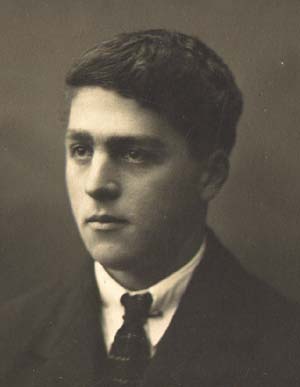
Gunner John Leith, 107th Bde, Royal
Field Artillery
John
Leith, the second son son of John and Jane Leith, was born
on 6th November 1896 on the family farm of Courtieston, Leslie.
John Leith, Snr died at Courtieston aged only 43 in 1904.
Shortly after, his widow and her five sons moved to the farm
of Piperwell at Duncanston, Kennethmont. It was from Piperwell
that John and his younger brother James left to go on active
service. James served in the Machine
Gun Corps and was also killed in action. This accounts
for the brothers being commemorated by name on both the Leslie
and Kennethmont War Memorials.
John was working as a farm servant at Tillyangus, Clatt when he
enlisted at Aberdeen and was assigned to the Royal Field Artillery,
107th Brigade. It is not known if he enlisted after May 1916
when universal conscription come into effect with a Military
Service Act applying to all men regardless of marital status
between 18 and 41 years. Working on a farm may have
been classed as a ' reserved occupation ' prior to this date.
It is known he was not in France or Flanders prior to 1916.
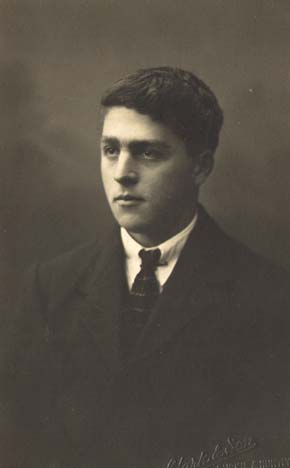
John
Leith
|
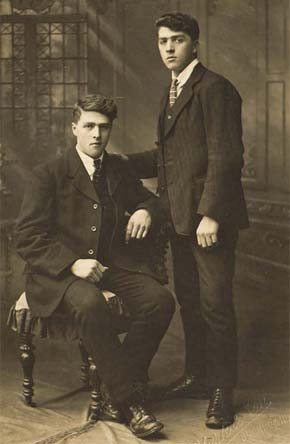
John
and James Leith
|
The
Brigade was the basic tactical unit of the field artillery
of the British Army in the Great War of 1914-1918. It was
composed of a Brigade Headquarters and a number of batteries
of guns or howitzers. At full establishment, a Brigade of
18-lbr field guns consisted of 795 men, of whom 23 were officers.
For a 4.5-inch Howitzer Brigade, this was 755 and 22.
Usually
lettered A, B and C each battery numbered 198 heads at full
establishment manning six 18 Pdr Field
Guns. The battery was commanded by a Major or Captain,
with a Captain as Second-in-Command, and 3 Lieutenants or
Second-Lieutenants in charge of 2-gun sections. Battery establishment
also included a Battery Sergeant-Major , a Battery Quartermaster
Sergeant , a Farrier-Sergeant, 4 Shoeing Smiths (of which
1 would be a Corporal), 2 Saddlers, 2 Wheelers, 2 Trumpeters,
7 Sergeants, 7 Corporals, 11 Bombardiers, 75 Gunners, 70 Drivers
and 10 Gunners acting as Batmen.
It
is known that John was a member of "B" Battery,
107th Brigade in the 24th Division. Prior to his death it
is likely the battery were in positions in the Zillebeke area
in preparation for the start of the artillery bombarment on
the German lines two miles away prior to The Flanders Offensive
or Battles of Third Ypres. This offensive opened on 7th June
1915 and culminated in the Battle of Passchendaele in November
of that year.
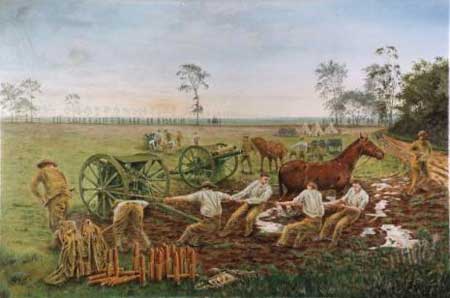
Painting
courtesy of Gerald J Giddins www.militaryartist.co.uk
Gunners
setting up a 18lb field gun in preparation for the opening
bombardment of 3rd Ypres.
There
were no actions taking place on the day on John's death but
it is quite likely he was injured by German shell fire directed
on his battery's position and evacuated to the Advanced Dressing
Station located at a farm, known by the British soldiers as
Transport Farm, near Zillebeke Lake. The ADS buried in the
cemetery which was established there in 1915. Transport Farm
Cemetery is also known as Railway Dugouts Burial Ground owing
to dugouts in the adjoining railway line embankment being
used to house an ADS which also buried its dead there.
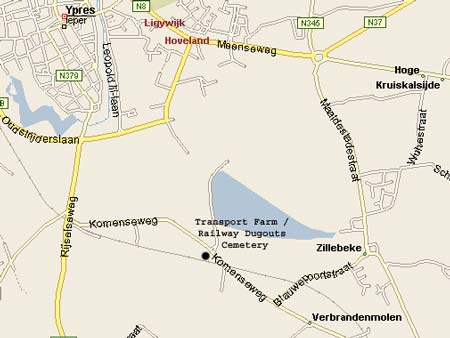
Location
of Transport Farm / Railway Dugouts ADS near Zillebeke.
|
Armaments
and Equipment
At the outbreak of war, field gun batteries of the Regular
Army had 6 guns, and those of the Territorial Force 4 guns.
The standard weapons, which did not alter during the war,
were the 18-lbr field gun, and the 4.5-inch howitzer.
Battalion
Transport consisted of 13 riding , and 43 draught and pack
horses. The provided the power for drawing the six ammunition
carts, two water carts, three General Service Wagons (for
tools and machine guns), and the MO's Maltese Cart. The Signallers
had 9 bicycles. (Note: the Divisional Train also provided
four more two-horsed GS Wagons for each Battalion.
Not
all ranks carried a rifle. Only 5 men in Brigade HQ, 36 in
each Battery, and all the Gunners and Drivers in the BAC were
thus equipped. Bayonets were not issued. All NCOs and men
wore a bandolier.
Other
Brigade equipment, over and above that carried by the man,
included 126 shovels, 18 spades, 72 pickaxes, 27 felling axes,
72 billhooks, 54 hand saws, 46 reaping hooks and a crowbar.
There was also a plethora of minor stores and spares.
The
Brigade also carried a certain amount of ammunition, although
this was backed up by the echelons of Transport at Divisional
and Lines of Communication levels.
Ammunition
stock (rounds per gun) 18-lbr 4.5-inch How.
At the battery position 176 108
With the Brigade Ammunition Column 76 48
With the Divisional Ammunition Column 126 44
At the Divisional Ammunition Park 150 80
Other reserves, on Lines of Communication 472 520
Total rounds per gun in the field (minimum) 1000 800
Especially
as the war progressed, it became rare for a Brigade to be
at full establishment with regard to men. Equipment was lost
and damaged, and not always replaced quickly or fully. Field
guns and howitzers were sometimes lost or abandoned to the
enemy, if his infantry penetrated the infantry positions.
The guns would almost always be destroyed first, by removing
sights or exploding a charge in the barrel or breech.
Each
Brigade had a detachment at its Base Depot, which did not
take the field when the Battalion was on active service. The
Base Detachment consisted - in theory - of a subaltern, 2
Sergeants, 5 Drivers and 41 Gunners to form a first reinforcement
(to make good Brigade casualties or other losses); 4 Storemen,
and a Sergeant-Clerk (who was on the headcount of the Records
Section of the Adjutant-General's Office).
John
Leith was awarded these medals for serving his King
and Country in The Great War.
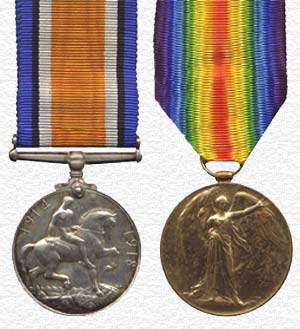
Move
mouse over medals to view reverse
The
British War Medal (left and Victory Medal (right)
were awarded to all personnel.
|
The British War Medal 1914-1918
The medal takes the form of a solid silver medal with
an image of a mounted figure of St George trampling
the shield of the central powers with the dates 1914
and 1918 thereon. At the base is a skull and crossbones,
symbolic of death, whilst above is the rising sun
of victory. The reverse has the coinage head of George
V.
Victory
Medal 1914 - 1919
It was decided amongst the Allies that a common theme
would be adopted and that each country would produce
a medal to commemorate the Victory. This medal took
various forms according to the country but a common
item was the rainbow coloured ribbon. The British
medal shows the winged victory on the front holding
a palm branch in her right hand with the left outstretched.
The reverse has the words "The Great War for
Civilisation" surrounded by a laurel wreath.
The pair were affectionately known as "Mutt and
Jeff".
|
|
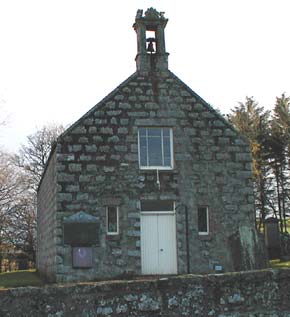
Leslie Kirk
and War Memorial
1914-
1919
Erected
by public subscription
in memory of
the undermentioned officers and men of Leslie Parish
who died on service during The Great War
Lieut
Col. Geo A Smith, DSO
Major
Harry T Lumsden
Capt John S Grant, M.C., B.D.
Corpl William Milne
Gunner John Leith
George Thomson
Private George Benzie
|
Private
Alex Gordon
Alex Jamieson
James Jamieson
John G Johnston
James Johnston
James Leith
|
Alex
Duncan - F Tough - James Petrie
~~~~~~~~~~~~~~~~~
1939
-- George J Morgan - John G Smith -- 1945
|
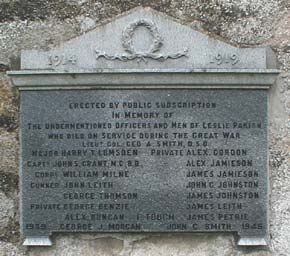
Leslie
War Memorial bears the names of John and James
Leith
|
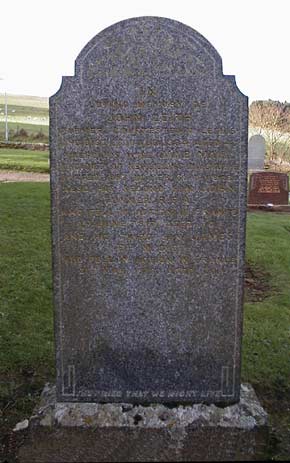
Leith
family headstone at Leslie
|
In
Loving Memory of
John Leith
Farmer, Courtieston, Leslie
who died 28th Aug 1904 age 43
Also his wife Jane Mair
who died at Newbigging, Inverurie
3rd Feb 1953 in her 89th year
Also his second son John
Gunner R.F.A.
who fell in action in France
1st June 1917 aged 20
and his third son James
Private
M.G.C.
who fell in action in France
21st March 1918 age 20
|
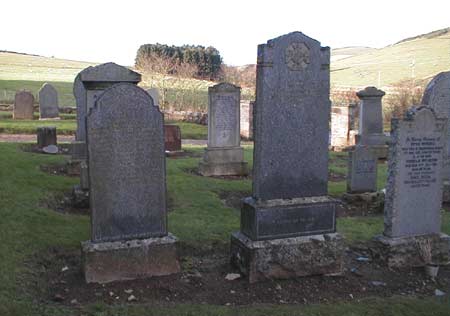
The Leith Family
headstone in Leslie Kirkyard
Photographed February
2002
The Next of Kin Memorial Plaque
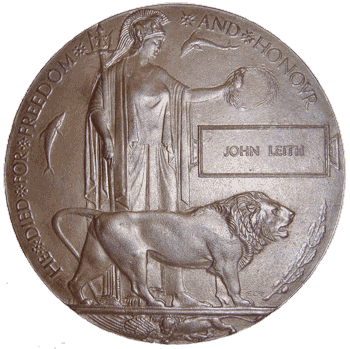
The Memorial Plaque
This circular bronze plaque, 4.75 inches (120mm) in diameter, was first issued in 1919 to the next of kin of those British and Commonwealth servicemen and women who lost their lives on active service during the Great War. Each one was different in that the commemorated individuals name was embossed in raised letters within a tablet.
The design shows Britannia bestowing a laurel wreath on the rectangular tablet. A lion stands in the foreground, with dolphins above and an oak branch in the lower right. A lion cub clutching a fallen eagle in its jaws decorates the exergue. The wording around the circumference states: HE (or SHE) DIED FOR FREEDOM AND HONOUR.
The final total manufactured is estimated to be in the vicinity of 1,150,000 units, and represented the most universally distributed numismatic work ever cast or struck, excluding money.
Due to some similarity with the old one pence coin it was commonly known as a Dead Man's or Death Penny. The plaques were despatched in stiff card wrapping enclosed within a white envelope bearing the Royal Arms.
|
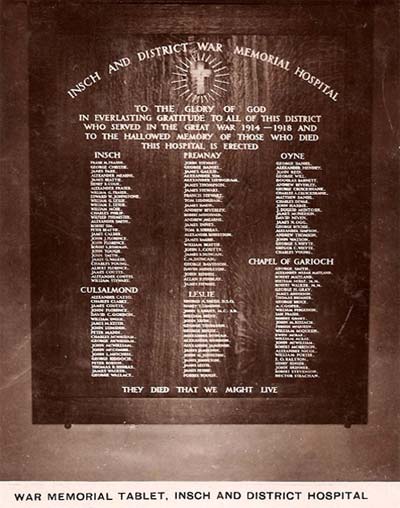
John Leith's name is also recorded within the entrance of Insch & District War Memorial Hospital
which was built as a memorial to the Fallen of neighbouring parishes including Leslie.
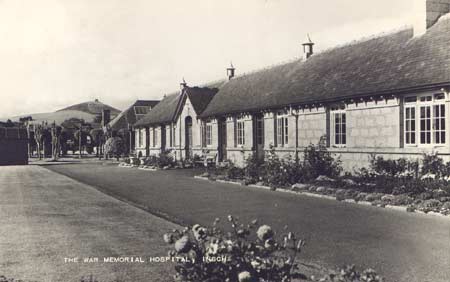
Use of the painting
'The gathering storm, 3rd Ypres, Royal Horse Artillery' by kind permission
of the artist Gerald J Giddins www.militaryartist.co.uk
Photographs of John are reproduced here by kind
permission
of his nephew Robert Leith, Inverurie.
|












